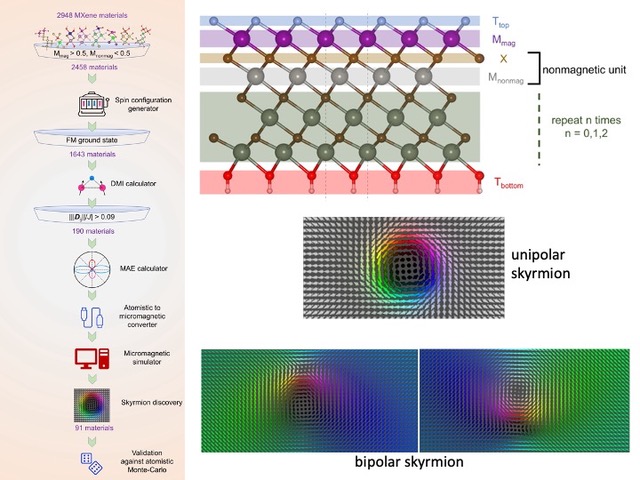Searching Skyrmions in 2D Magnets
In magnetic materials, spin vectors of magnetic atoms are typically arranged either in parallel (ferromagnetic) or antiparallel (antiferromagnetic) fashion due to the ‘symmetric exchange’ force. However, under special circumstances, spin vectors can be tilted because of ‘antisymmetric exchange’ force also known as Dzyaloshinskii-Moriya interaction (DMI). Such spin-canting leads to new type of tiny quasi particles in condensed matter known as “skyrmions”, where spins are arranged in a whirl, which can travel at very high speed under electric field. These particles are named after Skyrme (1962), who characterised them by a topological integer. Thus, there has been an increased activity to synthesise skyrmions due to their applications in alternative computing paradigms such as reservoir computing, neuromorphic computing as well as in racetrack memory.

Skyrmions initially were identified in liquid crystal. Currently, these particles are commonly realised by inducing large DMI in the interface of heavy metal heterolayers. These are complex structures are adversely affected by defects at the interface as well as the stacking order of the layers. With the discovery of 2D magnetism in 2017, scientists sought to host intrinsic skyrmions in monolayers, which would be free from any interfacial defect and stacking order. However, most of the 2D materials are centrosymmetric therefore making the possibility of realising skyrmions pretty slim.
With the advancement of computational science and supercomputing technology, in-silico search for application-specific materials has become extremely popular. Since the material space is infinite, it is impossible to explore all possibilities experimentally. In the current study, researchers developed a high-throughput automated workflow that rapidly scans a carefully curated large non-centrosymmetric MXene space to find materials capable of hosting typical unipolar and exotic bipolar skyrmions.
By exploiting the in-plane magnetism of the chosen 2D magnets, the researchers stabilise the bipolar skyrmions, which is usually challenging to realise in typical bulk materials. The researchers used high-fidelity exchange-corelation functional (R2SCAN), which is free from any empirical correction and they believe that the theoretical prediction is in good agreement with any future experimental efforts.
REFERENCE:
Kabiraj A, Mahapatra S, Realizing unipolar and bipolar intrinsic skyrmions in MXenes from high-fidelity first-principles calculations, npj Computational Materials (2023).
https://www.nature.com/articles/s41524-023-01129-x
LAB WEBSITE:
https://labs.dese.iisc.ac.in/nsdrl/




